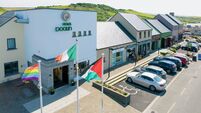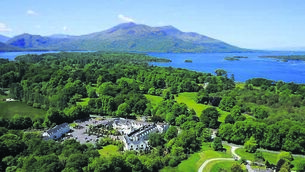Cambodia: beyond the Killing Fields
BETWEEN sparse clumps of trees, the ground dips in smooth, saucer-shaped hollows. No birds sing. It is bouncy underfoot, as if you are treading on invisible hands pushing upwards towards the surface. In fact, you are walking over the compacted bones of the thousands of corpses buried by the Khmer Rouge revolutionaries between 1975 to 1979, when they had run out of burial sites in the Cambodian capital, Phnom Penh.
People walk quietly, talking in hushed voices. These are the killing fields at Choeung Ek, 10 miles from the city centre, where “enemies of the state” were brought in lorry loads to be clubbed unconscious and finished off beside an open pit with a spade blow to the back of the neck — bullets being too precious to waste on humans. A paved walk leads to a circular, glass-and-concrete tower, each of its 17 storeys crammed with skulls. So far, 388 extermination camps have been found. Out of a population of seven million, around two million were killed during the four years of the Khmer Rouge’s murderous reign.
Nearly 30 years ago I wrote a book, The Killing Fields, which, like the film, had its genesis in a prize-winning New York Times article by Sydney Schanberg, The Death and Life of Dith Pran. The story will still be familiar to many readers — it is about Schanberg and his Cambodian assistant, Dith Pran, who bravely volunteered to stay on in Phnom Penh after it had fallen, and helped save Schanberg’s life. Schanberg was airlifted to safety, but Pran had to endure four years of unremitting horror until Schanberg found him again.
Back then in 1983, when I began writing about it, I knew only as much as the average Westerner about the Cambodian tragedy. But as I immersed myself in Dith Pran’s story — from thousands of miles away in a flat in Notting Hill, London — it took me under its spell. Years passed — other stories, other memories. It wasn’t until friends began returning from Cambodia with pirated copies of The Killing Fields that I woke up to my neglect.
For 10 years after their defeat of the Khmer Rouge in 1979, the Vietnamese called the shots. In Phnom Penh electricity remained sporadic and only 1% of the population had access to clean water. Meanwhile, Cambodians waited in vain for the world to provide humanitarian aid.
I expected to see the scars when my wife and I flew in a few weeks ago. I was proved wrong. Central Phnom Penh is cosmopolitan, graceful and surprisingly sophisticated.
Men sit in cafés nursing beers (a habit taken from the French), boulangeries abound, and scooters whizz past carrying slim, pretty girls holding up parasols. The wide boulevards, shaded by jacarandas and tamarind trees, survive. The stately, white colonial houses are now inhabited by Cambodia’s elite. The beautifully kept gardens beside the Royal Palace, and the square where the royal elephants were stabled, now host an evening passeggiata of strolling Khmer families.
For 15 years, from 1975 to 1990, Phnom Penh remained frozen in time, ever since the black-clad revolutionaries drove the entire urban populace into the countryside in a mad attempt to create a pure, agrarian society. Now it is like a time capsule, one of the few remaining capital cities to preserve the sense of a vanished Indo-China.
Its great colonial landmark, the Hotel Raffles Le Royal, is a mirror of Phnom Penh’s changing fortunes. One of the capital’s grandest buildings, it was constructed in 1929 and became a port of call for the rich and stylish. In the Fifties, during the heyday of King Sihanouk, it was a mecca for cosmopolitan tourists. Later, during the Vietnam War in the Seventies, it became the hang-out of hard-drinking, hard-living war reporters. Jon Swain recalls having to decamp from the hotel’s top floor to the bottom when the shelling became too intense.
Raffles got by, serving as an emergency hospital and first-aid post. The ambience is unmistakable, from the high-ceilinged rooms and black-and-white tiled floors down to the mynah bird chattering in a centuries-old rain tree.
We are lucky. We have reached Phnom Penh in time to see the capital as it must have looked earlier in the last century, with little development along the riverside except for a Vietnamese floating village. But the first high-rises are beginning to go up: in years to come Phnom Penh will start looking like any other capital in the Far East. Tourists are arriving but not in any great numbers. Few visit the National Museum, with its collection of graceful Khmer statuary.
Our guide, Tee, is a scholar who worked at the museum like his uncle before him. He has deep-set eyes and a kindly expression and when I ask him how he survived Pol Pot’s decimation of the intellectuals, his eyes take on a faraway look.
He was a child when the Khmer Rouge came. Luck sent him to tend the buffalo in the rice fields; there, far from spying eyes, he could catch and eat fish to supplement the starvation diet. (The Khmer Rouge sent the rice harvest to China in exchange for guns.) His family was careful, keeping their heads down and working diligently. But when they were ordered back to Phnom Penh, his father was recognised as an educated man, cruelly tortured, then killed.
There was one place in Phnom Penh that I had left for last. It used to be the Tuol Sleng primary school. From 1975 to 1978 it was converted into a secret facility for torture and extermination called S-21. Run by Duch, a former maths teacher who became one of the Khmer Rouge’s most feared inquisitors (he had, days before we arrived, been sentenced to life imprisonment for war crimes), life at S-21 was horrifyingly brutal. Death came at random, for something as insignificant as leaning against a wall. “Interrogations” could last for weeks, the screams unheard in a deserted capital city. One block, in what is now the Tuol Sleng Genocide Museum, has been left as it was. One cell has a bloodstained ceiling: a sense of evil pervades the whole compound like a stench.
The most haunting testament to survive is the collection of black-and-white photographs documenting each prisoner’s arrival. Cowed, dazed, some heartbreakingly young, they stare out at us. Most striking are the former Khmer Rouge cadres, boys and girls, some as young as 10, blank-faced, with nothing behind their eyes.
The next day we head for Battambang, travelling on roads raised to cope with the annual rains. Villagers build their houses on stilts above the flooded rice fields.
Life goes on in these cool, dark spaces underneath the house, where hammocks swing gently in the shade. Outside in the sun, a girl walks home clutching a lotus leaf as a makeshift sunshade, while a man holds his water buffalo on a leash as it wallows in an irrigation ditch. Plastic bags by the roadside contain lights to catch crickets, a prized delicacy; piglets travel to market in a bamboo basket strapped to the back of a motorbike.
Under the Khmer Rouge, there were, of course, no markets — nor money or schools or medicine. Even family life was forbidden: “familyism”, the term for missing one’s relatives, was a crime, often punishable by death.
THE small town of Battambang is a popular tourist destination. It is a sleepy place, its wide, tree-shaded streets near the river lined with French colonial architecture. Our hotel, renovated in Thirties style, is understandably described as “one of Cambodia’s most romantic and evocative boutique hotels”. But when we arrive it is to find that La Villa is now dwarfed by two massive hotels, one of them under construction just feet away. Good food, in a shady courtyard, restores our spirits.
Battambang’s thriving streets show that life has taken off here. We find, of all things, a vineyard which sells a fine brandy and is being wooed by a Californian winemaker. And we suffer a terrifying train journey — sitting on an open trolley on a narrow-gauge railway, rattling along at 20mph — nothing in front of us but a frail bamboo rail. The Bamboo Train, used to transport villagers and their wares, has become a thrill for passing tourists. The train pulls in at a couple of shacks where friendly Khmer families sell drinks and woven handicrafts. Conversation is relaxed: no one begs and no one hassles us. Yet always, among these gentle, courteous people, reminders of the nightmare persist.
We visit Battambang’s Heritage House, an old wooden mansion from more stately days. Its owner, a dignified old lady, still lives there, eking out a living. In a mix of French and Cambodian, her story emerges.
They were a prosperous, well-educated family who suffered dreadfully under the Khmer Rouge. Her home survived because the cadres used it as a communal dining-hall. But she lost four children, her husband, parents, brother and sister — of 20 in her family, only one cousin remains. I am unable to speak for several moments. My wife moves away, in tears. “Ah, vous avez des sentiments pour moi,” observes the old lady simply: she is far beyond crying.
Later that day I am taken to Phnom Sampeau, a temple complex on a high, rocky outcrop, crowned by a golden stupa. We are shown a machine-gun nest and two deep, narrow caves into which the KR threw people after beating them unconscious. Following their own twisted logic, they reserved a separate cave for infants.
Although it’s only mid-February, on the drive to Siem Reap we notice paddy fields being prepared for planting. Rice is Cambodia’s sustenance, its economy. Yet there is still land which is farmed at the risk of being killed or disabled. In the north-west, near the Thai border, countless mines were sown.
One of our most inspiring visits is to the Landmine Museum, set up by a former Khmer Rouge child-soldier, Aki Ra. From the age of 10, when he was given an AK47, Aki Ra sowed thousands of mines. After the war, he became a one-man removal dynamo, personally defusing as many as he had sown. But the residue of unexploded bombs and mines will take years to clear and there are no maps identifying where they are. Tourist areas are safe but elsewhere, stay on well-used paths.
This area south-west of Siem Reap is Dith Pran’s country, where he was born, almost in sight of the temples of Angkor Wat. He went back in 1989 and stopped at a mass grave where, 10 years earlier, as a punishment, the Vietnamese had ordered their Khmer Rouge prisoners to dig up the buried bones and skulls. Some belonged to Pran’s family: his father and three brothers had all been murdered here. On being shown these scattered bones in 1989, Pran began, tearfully, to rearrange them with his own hands.
Considering this history of civil war, famine and invasion in the space of a generation, it is astounding how little bitterness we found. We remind ourselves that these are the people who, in the 12th century, built the greatest city of temples known to mankind. If your guide is as good as ours, he will know to approach the East Gate of Angkor Wat around 9am, thus avoiding the Chinese, Japanese and Koreans, who crowd together on the west side to watch the sunrise and then return to breakfast in their hotels. We walk alone through the forest and come to the magnificent temple, supposedly the largest religious building in the world, silhouetted against the sky. By doing the itinerary in reverse, we have the same comparative solitude at the beautiful but disquieting Bayon temple, where 216 enigmatically smiling giant faces carved out of sandstone watch our every move.
Our best day is reserved until last, when we drive out of Siem Reap to the isolated and recently de-mined temple complex at Koh Ker, once Cambodia’s capital. These 10th-century temples, long buried in the jungle, combine austere beauty with a touch of Indiana Jones. On the way back we visit the temple of Beng Mealea, an hour from Siem Reap. Still locked in an embrace with the encroaching jungle, its vast root systems, giant trees and dislodged piles of stones make Ta Prohm, judged the most atmospheric ruin at Angkor, look tame by comparison.
Back at the Raffles Grand Hotel d’Angkor, we have drinks with an ex-cabinet minister. A child labourer for the Khmer Rouge, he managed to escape and end up, through family contacts, in Australia. One day he saw billboards for a new film, The Killing Fields. Sitting in the darkened cinema, he realised with anguish and relief that at last the world knew of Cambodia’s suffering. Shortly afterwards, he booked a one-way ticket home. He became a cabinet minister at the age of 28.
Such stories are told to me time and again. And I reflect that in not coming to Cambodia for all those years I had left something unfinished which has only now been mended.
© Christopher Hudson / The Daily Telegraph










